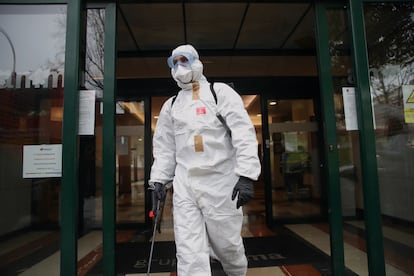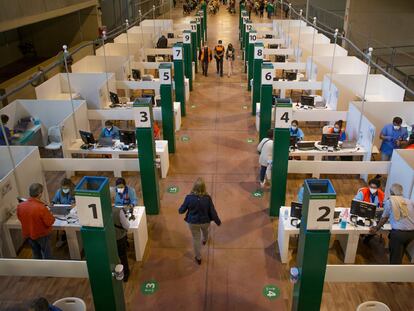Coronavirus crisis: 73% of nursing home victims in Madrid were not transferred to hospital
Regional data shows that during the first wave most Covid-19 patients from senior residences died in their care home, not in a medical center as claimed by premier Isabel Díaz Ayuso


Seven in 10 Covid-19 patients in nursing homes in Madrid died from the disease without ever being taken to hospital. According to data from the Madrid regional government, 11,389 nursing home residents died from Covid-19 during the first wave of the pandemic, of whom 8,338 – a total of 73% – were not transferred to a medical center. The victims were instead left to die in care homes that often lacked resources to treat patients and the conditions for a dignified death.
These figures contradict Madrid premier Isabel Díaz Ayuso of the conservative Popular Party (PP), who has maintained throughout her reelection campaign for the May 4 regional poll that seven in 10 senior home residents died in the hospital. The data from her own government show the opposite is true.
The situation was the same across the board in all of the 26 public hospitals in Madrid for which there are data, according to a study by epidemiologist María Victoria Zunzunegui, who specializes in geriatric care. The study, which was shared with EL PAÍS, reviews deaths from all causes between March 8 and July 7, 2020 – which is when there are figures on the fatalities in each hospital.

Each senior residence in Madrid was assigned a public hospital in the area. But internal documents from the Madrid government show that regional officials issued protocols with criteria to exclude some nursing home residents from being transferred to hospitals. This protocol, which was reported by Amnesty International as a serious human rights violation, aimed to prevent the hospital system from reaching breaking point.
Of the 26 hospitals analyzed, the Sureste Hospital in the municipality of Arganda del Rey and the Infanta Cristina Hospital in Parla were the strictest adherents of the protocol: 83% of Covid-19 victims at the 28 nursing homes assigned died at these centers – not in the hospital. Indeed, a medical director at the Infanta Cristina Hospital was caught on camera telling staff that senior care home residents would not be admitted. “This is drastic. It is horrible. I wish this hadn’t happened to us,” he is heard saying in the video.
On the other end of the spectrum, the Clínico San Carlos Hospital was the most receptive of senior residents: 61% of Covid-19 victims at the 15 centers assigned to it died in the care home. The Monte Hermoso senior residence is one of the 15 centers that depend on the hospital. This care home made headlines last year on March 17, when it was revealed that the bodies of residents were piling up in its basement due to difficulties with getting patients transferred.
Every geriatrician, every health worker made the best decision they could at that momentMadrid premier Isabel Díaz Ayuso
The full extent of the breakdown between hospitals and senior residences is not known as there is only official data from the period between March 8 and July 7, 2020. Hospitals, however, remained under pressure until mid-April, after which point the number of transfers from nursing homes began to rise.
Díaz Ayuso has claimed that ambulances made thousands of transfers between hospitals and senior residences, but these fell dramatically when the triage protocol was introduced. What’s more, there is overwhelming evidence that ambulances were making the opposite trip: transferring seniors back to care homes to free up a bed for other patients.
Ahead of the Madrid regional election, the premier also told EL PAÍS that 70% of nursing home victims died in the hospital, despite evidence to the contrary. She has also labeled any attempt to investigate discrimination against senior residents as “insensitive.” “I clearly understand that going to a hospital did not mean you were going to be saved,” she told this newspaper. “Every geriatrician, every health worker made the best decision they could at that moment. And now, to start to question what that geriatrician or health worker did when the tsunami [of coronavirus patients] hit is very forced. Because we weren’t there.”
Several courts in Madrid received collective lawsuits against Díaz Ayuso, regional health chief Enrique Ruiz Escudero and justice chief Enrique López for involuntary manslaughter, degrading treatment and failure to provide assistance.
Lack of transparency
The study by Zunzunegui cross-references official data from the Madrid region between March 8 and July 7 and the list of nursing homes assigned to each hospital. EL PAÍS was given the list of deaths in July after filing a freedom of information request. This figure includes deaths from all causes and in all sites.
Determining the real number of Covid-19 victims among senior homes residents, however, continues to be difficult. The Madrid government only provides a toll with the number of fatalities inside care facilities, meaning the number of deaths in hospitals is not known. This information is key to assessing what happened in Madrid during the second and third waves, when there were devastating outbreaks in nursing homes.
Since March 2021, the public social services agency Imserso has been keeping track of deaths in senior residences in all of Spain’s 17 regions. Even with the incomplete data from Madrid, the figures show that the region has the highest total number of deaths in senior homes – 6,197.
English version by Melissa Kitson.
Tu suscripción se está usando en otro dispositivo
¿Quieres añadir otro usuario a tu suscripción?
Si continúas leyendo en este dispositivo, no se podrá leer en el otro.
FlechaTu suscripción se está usando en otro dispositivo y solo puedes acceder a EL PAÍS desde un dispositivo a la vez.
Si quieres compartir tu cuenta, cambia tu suscripción a la modalidad Premium, así podrás añadir otro usuario. Cada uno accederá con su propia cuenta de email, lo que os permitirá personalizar vuestra experiencia en EL PAÍS.
¿Tienes una suscripción de empresa? Accede aquí para contratar más cuentas.
En el caso de no saber quién está usando tu cuenta, te recomendamos cambiar tu contraseña aquí.
Si decides continuar compartiendo tu cuenta, este mensaje se mostrará en tu dispositivo y en el de la otra persona que está usando tu cuenta de forma indefinida, afectando a tu experiencia de lectura. Puedes consultar aquí los términos y condiciones de la suscripción digital.
More information
Últimas noticias
Most viewed
- Sinaloa Cartel war is taking its toll on Los Chapitos
- Oona Chaplin: ‘I told James Cameron that I was living in a treehouse and starting a permaculture project with a friend’
- Reinhard Genzel, Nobel laureate in physics: ‘One-minute videos will never give you the truth’
- Why the price of coffee has skyrocketed: from Brazilian plantations to specialty coffee houses
- Silver prices are going crazy: This is what’s fueling the rally









































